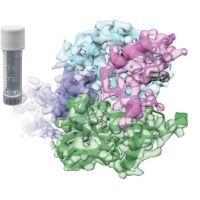Specification
| Organism | Canine distemper virus (strain Onderstepoort) (CDV) |
| Expression Host | E.coli |
| Tag Info | N-terminal 6xHis-SUMO-tagged |
| Purity | Greater than 85% by SDS-PAGE |
| Uniprot ID | P12569 |
| Gene Names | F |
| Alternative Names | F; Fusion glycoprotein F0 [Cleaved into: Fusion glycoprotein F2; Fusion glycoprotein F1] |
| Expression Region | Partial(136-608aa ) |
| Molecular Weight | 67.5 kDa |
| Protein Sequence | QIHWDNLSTIGIIGTDNVHYKIMTRPSHQYLVIKLIPNASLIENCTKAELGEYEKLLNSVLEPINQALTLMTKNVKPLQSLGSGRRQRRFAGVVLAGVALGVATAAQITAGIALHQSNLNAQAIQSLRTSLEQSNKAIEEIREATQETVIAVQGVQDYVNNELVPAMQHMSCELVGQRLGLRLLRYYTELLSIFGPSLRDPISAEISIQALIYALGGEIHKILEKLGYSGSDMIAILESRGIKTKITHVDLPGKFIILSISYPTLSEVKGVIVHRLEAVSYNIGSQEWYTTVPRYIATNGYLISNFDESSCVFVSESAICSQNSLYPMSPLLQQCIRGDTSSCARTLVSGTMGNKFILSKGNIVANCASILCKCYSTSTIINQSPDKLLTFIASDTCPLVEIDGATIQVGGRQYPDMVYEGKVALGPAISLDRLDVGTNLGNALKKLDDAKVLIDSSNQILETVRRSSFNFGS |
| Form | Liquid or Lyophilization |
| Buffer | The default storage buffer is Tris/PBS-based buffer, 5%-50% glycerol if the delivery form is liquid. The lyophilization buffer is Tris/PBS-based buffer, 6% Trehalose, pH 8.0 if the delivery form is lyophilized powder. Please contact us if you have any special requirment. |
| Reconstitution | Please reconstitute protein in deionized sterile water and we recommend that briefly centrifuge thevial prior to opening the vial .We recommend aliquot for long-term storage at -20℃/-80℃. |
Background
| Relevance | Class I viral fusion protein. Under the current model, the protein has at least 3 conformational states: pre-fusion native state, pre-hairpin intermediate state, and post-fusion hairpin state. During viral and plasma cell mbrane fusion, the heptad repeat (HR) regions assume a trimer-of-hairpins structure, positioning the fusion peptide in close proximity to the C-terminal region of the ectodomain. The formation of this structure appears to drive apposition and subsequent fusion of viral and plasma cell mbranes. Directs fusion of viral and cellular mbranes leading to delivery of the nucleocapsid into the cytoplasm. This fusion is pH independent and occurs directly at the outer cell mbrane. The trimer of F1-F2 (F protein) probably interacts with H at the virion surface. Upon HN binding to its cellular receptor, the hydrophobic fusion peptide is unmasked and interacts with the cellular mbrane, inducing the fusion between cell and virion mbranes. Later in infection, F proteins expressed at the plasma mbrane of infected cells could mediate fusion with adjacent cells to form syncytia, a cytopathic effect that could lead to tissue necrosis . |
| Involvement in Disease | |
| Subcellular Location | Virion membrane, Single-pass type I membrane protein, Host cell membrane, Single-pass membrane protein |
| Protein Families | Paramyxoviruses fusion glycoprotein family |
| Tissue Specificity | F |
QC Data
| Note | Please contact us for QC Data |
| Product Image (Reference Only) |  |

